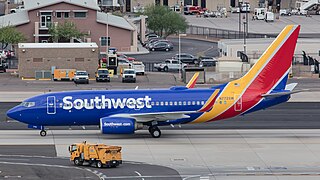
Aloha Airlines Flight 243 was a scheduled Aloha Airlines flight between Hilo and Honolulu in Hawaii. On April 28, 1988, a Boeing 737-297 serving the flight suffered extensive damage after an explosive decompression in flight, caused by part of the fuselage breaking due to poor maintenance and metal fatigue. The plane was able to land safely at Kahului Airport on Maui. The one fatality, flight attendant Clarabelle "C.B." Lansing, was ejected from the airplane. Another 65 passengers and crew were injured. The substantial damage inflicted by the decompression, the loss of one cabin crew member, and the safe landing of the aircraft established the incident as a significant event in the history of aviation, with far-reaching effects on aviation safety policies and procedures.
Pacific Western Airlines Ltd (PWA) was an airline that operated scheduled flights throughout western Canada and charter services around the world from the 1950s through the 1980s.
This is a list of aviation-related events from 2005.
Aerosucre S.A. is a cargo airline based in Bogotá, Colombia. It began operation in 1969 and operates scheduled international and domestic cargo services throughout Latin America and the Caribbean. Its home base is El Dorado International Airport, Bogotá. Aerosucre has been involved in a number of accidents and incidents during its lifetime, and more recently, internet videos have emerged showcasing reckless behavior by its pilots.
The article describes accidents and incidents on Korean Air and its predecessor companies Korean National Airlines and Korean Air Lines.

A turbine engine failure occurs when a turbine engine unexpectedly stops producing power due to a malfunction other than fuel exhaustion. It often applies for aircraft, but other turbine engines can fail, like ground-based turbines used in power plants or combined diesel and gas vessels and vehicles.

Continental Airlines Flight 1404 was a Continental Airlines domestic flight from Denver International Airport in Denver, Colorado, to George Bush Intercontinental Airport in Houston, Texas. On the evening of December 20, 2008, the flight crashed while taking off from Denver, resulting in two critical injuries, 36 noncritical injuries, and a hull loss of the Boeing 737-500 aircraft.

On 11 February 1978, Pacific Western Airlines Flight 314, a Boeing 737-200, crashed at Cranbrook/Canadian Rockies International Airport, near Cranbrook, British Columbia, Canada, killing 43 of the 49 people on board.

The 1990 Wayne County Airport runway collision involved the collision of two Northwest Airlines jetliners at Detroit Metropolitan Wayne County Airport on December 3, 1990. Flight 1482, a scheduled Douglas DC-9-14 operating from Detroit to Pittsburgh International Airport, taxied by mistake onto an active runway in dense fog and was hit by a departing Boeing 727 operating as Flight 299 to Memphis International Airport. One member of the crew and seven passengers of the DC-9 were killed.
In aeronautics, loss of control (LOC) is the unintended departure of an aircraft from controlled flight and is a significant factor in several aviation accidents worldwide. In 2015 it was the leading cause of general aviation accidents. Loss of control may be the result of mechanical failure, external disturbances, aircraft upset conditions, or inappropriate crew actions or responses.

American Airlines Flight 383 was a scheduled passenger flight from O'Hare International Airport in Chicago, Illinois to Miami International Airport. On October 28, 2016, the Boeing 767-300ER operating the flight suffered an engine fire during takeoff. The crew aborted their takeoff, evacuating everyone on board, of whom 21 were injured. The plane was a write-off.

Southwest Airlines Flight 1380 was a Boeing 737-700 that experienced a contained engine failure in the left CFM International CFM56 engine after departing from New York–LaGuardia Airport en route to Dallas Love Field on April 17, 2018. The engine cowl was broken in the failure, and cowl fragments damaged the fuselage, shattering a cabin window and causing explosive depressurization of the aircraft. Other fragments caused damage to the wing. The crew carried out an emergency descent and diverted to Philadelphia International Airport. One passenger was partially ejected from the aircraft and sustained fatal injuries, while eight other passengers sustained minor injuries. The aircraft was substantially damaged.

On February 20, 2021, United Airlines Flight 328 (UA328/UAL328), a scheduled U.S. domestic passenger flight from Denver to Honolulu, suffered what was technically ruled a contained engine failure despite shedding large pieces of debris, approximately four minutes after takeoff from Denver International Airport (DEN). Parts departing from the engine cowling of the Boeing 777-222 aircraft resulted in a debris field at least 1 mile (1.6 km) long over suburban residential areas of Broomfield, Colorado. Falling debris was recorded by eyewitnesses using smartphone cameras and a dash cam. Debris fell through the roof of a private home and significantly damaged a parked vehicle.









